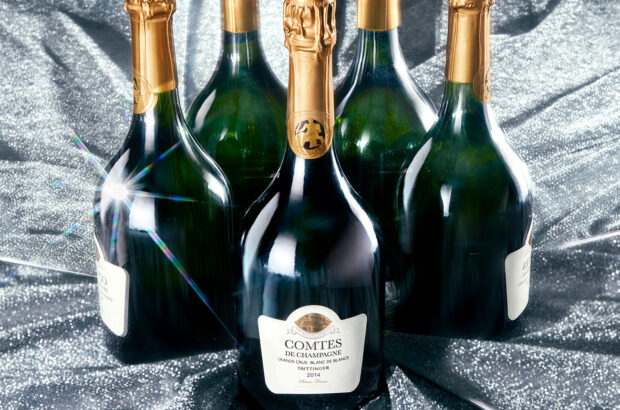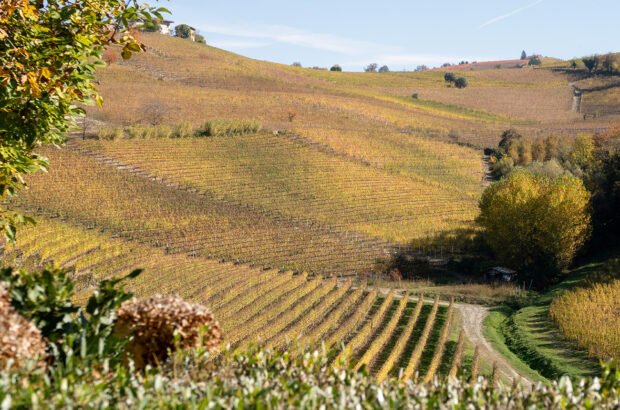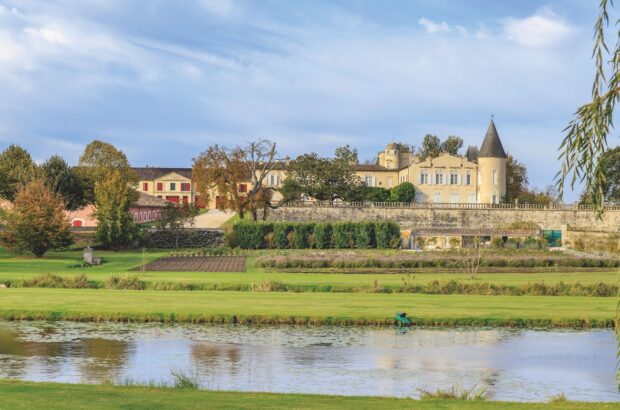Lying at the foot of the Alps in the northwestern corner of Italy, Piedmont is sheltered on three sides by mountains (the Alps and Apennines), and blessed with the ideal climate for viticulture. Here, the vines and landscapes seem to create a living painting: simply letting your gaze wander down the rows of vines provides a sense of plenitude rivalled by few places on earth.
Piedmont embodies the history and culture of Italian wine and draws wine lovers from around the world. It is famous for its ‘Three Bs’ – Barolo, Barbaresco and Barbera. The first two, made only from Nebbiolo grapes, are its most prestigious wines; the third is for everyday drinking. That said, the region’s sheer diversity of native varieties can leave even the most clued-up connoisseur feeling overwhelmed. The vines planted on this well-suited terroir are often centuries-old, nurtured by generations of skilled wine-growers who have clung to tradition and produced some incredible wines.
Fact file: Piedmont
Planted area 44,667ha
Climate Continental
Key regions Barolo DOCG, Barbaresco DOCG, Roero DOCG, Asti DOCG
Key grapes Red Nebbiolo, Barbera, Dolcetto; White Moscato Bianco, Arneis, Cortese, Erbaluce
Immersive Langhe
All of Piedmont’s wine-growing zones make fantastic destinations for gastronomic, viticultural and cultural tours, and can be loosely grouped into four macro-areas. First, let’s head into the heartland of Piedmont wine: Langhe e Roero, with its bucolic landscape dominated by hills scattered with vineyards, is on the UNESCO World Heritage List. Alongside the iconic Barolos and Barbarescos, other wines to taste here are Arneis (white), Roero (mainly Nebbiolo) and Dogliani (Dolcetto).
There are some 14 regional wine shops, many housed in castles and stately homes, which offer buying advice and tastings. The area is also home to the celebrated white truffle – the town of Alba holds an annual truffle festival during October and November – and there are many shops selling this local treasure. Take your love of truffles a step further and accompany a trifolau (truffle-hunter) with his faithful tabui (truffle-hunting dog), or enjoy a tasting experience: book through the Centro Nazionale Studi Tartufo.
And be sure not to miss the Saturday food market in Alba’s streets and squares. As well as truffles, one of the world’s finest hazelnut varieties, the IGP Nocciola Tonda Gentile, is cultivated here and is the key ingredient for many of the local sweets and desserts.
If you love walking, the Mangialonga is a 4km hike through the vineyards of La Morra, with plenty of food and wine tasting along the way. Suspended in 2020 due to Covid-19, it will next be held on 29 August 2021. Meanwhile the Collisioni festival in Barolo blends rock music, literature, food and wine. Major performers from around the world take part in it every July – although not in 2020.
What else to do in this part of Piedmont? You can wander among the castles, through the villages and museums (particularly the WiMu wine museum and Corkscrew Museum, both in Barolo), and marvel at the panoramic views over the Langhe.
So much to see
Venturing northwards, in Alto Piemonte Nebbiolo creates fresher, less structured wines – particularly in Gattinara and Ghemme – than its cousins in the Langhe. You’ll also find white wines made from the Erbaluce grape, in sparkling, dry still and dessert passito styles. You could visit Novara, where the Basilica di San Gaudenzio is famous for its monumental 121m-high cupola designed by Alessandro Antonelli and added in the 1880s – climb up for sweeping vistas over the city as far as Monte Rosa in the Alps to the northwest; while the city’s Castello Visconteo Sforzesco, is set in one of Piedmont’s loveliest parks.
Heading back south, the next stop is in the third macro-area, Monferrato. Another World Heritage Site, famous for its Infernòt (series of unique, hand-dug wine cellars), this is the home of Barbera, Dolcetto and Cortese, but also the birthplace of Italy’s earliest sparkling wines in the last of our macro-areas: Asti. As you explore the vast underground cathedrals dug into the tufa in Canelli, and meander around castles, craft shops and cultural sights, make sure to enjoy some Moscato d’Asti, Barbera d’Asti and Ruchè di Castagnole.

Credit: Maggie Nelson
Wineries to visit in Piedmont
Antichi Vigneti di Cantalupo
Ghemme is at the heart of northern Piedmont’s time-honoured wine country. Here, Alberto Alunno has managed Cantalupo since 1981 and is devoted to his native terroir, which boasts an exceptional – albeit not unique – mineral complexity that imbues Ghemme Nebbiolos with finesse and elegance. Alunno’s wines are a prime example – treat yourself to a taste of one of the older vintages. The estate’s nerve-centre is its spectacular 1,200m2 cellar built beneath the hillside: an underground amphitheatre of wide steps stacked with barrels of various sizes mirrors the gradient of the slope above. Upon entering, you are met with an awe-inspiring view of all the precious casks displayed in this ‘theatre of ageing’. A door leads to a corridor lined with small cells that can each store up to 5,000 bottles. Divided by cru, the bottles slumber there for at least a year, nestled in red velvet.
Bera Valter
If Neviglie has become a favourite port of call for many Moscato lovers, it owes much of its fame to the efforts of the Bera family, which stretches back centuries. The Bera winery sits on the road leading to the medieval village, immortalised by the Piedmontese writer Beppe Fenoglio. It’s worth visiting for a stroll around the winding streets and its sweeping views of the surrounding hills. The manor house stands majestically on the vine-clad hill to the left of the road, with the new house and modern, recently expanded winery below. If you’re after a superb Moscato d’Asti, look no further – Bera is a standard-bearer. Valter began bottling it in the 1970s, and now works with his sons Umberto and Riccardo. While best known for their Moscato, more recently the family has branched out to make Nebbiolo-based wine too.
Braida
As a local singer-songwriter put it, ‘this town has no surprises: a church, six houses and 10 vineyards’ – but there are plenty of reasons to visit Rocchetta Tanaro. Here, Giacomo Bologna ‘Braida’ (he lent his family nickname to the winery) made history with his innovative cask-aged Barbera. You’ll be able to taste a range of the estate’s Barberas, from the lightest, most frivolous offerings to more lush and complex ones. With his irresistible friendliness, enthusiasm and empathy, Giacomo Bologna put Rocchetta Tanaro on the map; a town where one can still sense the infectious personality of this special man who adored his land, its wine (made from Barbera), his family and friends. His two children, Raffaella and Giuseppe, are both oenologists and have inherited their father’s values, smilingly describing themselves as ‘dynamic conservatives’. The warm welcome you’ll be given by this remarkable family is as moving and memorable as the wines themselves.
Castello di Neive
Set among rolling, vine-covered hillsides is the 18th century Castello di Neive, with dreamy views across the landscape. Close to Barbaresco, Neive is one of Italy’s prettiest villages. In the 19th century, oenologist Louis Oudart (later employed by the Savoy royals to help create the first Barolo) created some fine red wines in the castle cellars. The Castello’s more recent history began when the Stupino family bought the property in the 1960s. Today, the affable Italo runs the estate – he helped bring about the comeback of the white Arneis grape and began a clonal selection programme here in 1982. This winery is worth visiting just for the stunningly beautiful castle itself, its vaulted cellar filled with wooden casks. But taste its Barbaresco, from the monopole cru of Santo Stefano – one of the most important vineyards in the Langhe.

Ceretto’s transparent ‘grape’ tasting suite juts out over its vineyards at Alba
Ceretto
From its headquarters at Tenuta Monsordo Bernardina, Alba, the Ceretto family oversees three other wineries (in Castiglione Falletto, Barbaresco and Santo Stefano Belbo), covering a total of 160ha, with vineyards in the most prestigious crus. Patrons of the arts, the Cerettos are also passionate foodies, operating two restaurants and a patisserie, where the star ingredient is Piedmont hazelnuts. Visit for not one, but several unique experiences. Take in the giant transparent ‘grape’ jutting out over the vineyards at Alba, for wine tastings immersed in nature. Equally striking is the clear glass cube set into the hilltop at Bricco Rocche; and the Chapel of Barolo at the Brunate vineyard, reinterpreted by artists Sol LeWitt and David Tremlett. Alessandro Ceretto, the third generation of the family at Ceretto, began converting the vineyards to organic farming in 2010. They received certification in 2016, and all the crus are now farmed biodynamically. The wines are pleasingly stylish, elegant and enjoyable.
La Raia
A microcosm of wellbeing and an oasis of biodiversity: this is La Raia. Owned by the Rossi Cairo family, this enchanting place allows visitors to revel in nature as they sample a selection of impressive Gavi wines. Step inside and the experience will stay with you forever. The project began in 2003 in the heart of Gavi, home of the Cortese grape. The estate now includes a Demeter-certified biodynamic winery; a farmstay with restaurant, spa and pool; a reimagined Italian garden; a park with display of contemporary artworks, and a cultural foundation. Its 180ha comprise 45ha of vineyards, along with arable land, cattle pastures, hazelnut groves and woods of chestnut, acacia, alder and oak, which provide habitats for numerous wildlife species. The winery’s one-of-a-kind cellar features a glass wall and rammed earth construction, built using the age-old, eco-sustainable pisé technique, which lends its name to the estate’s Gavi cru, Pisé.
Malvirà
This family-run estate was founded in 1974 on just 2ha. Today it covers 42ha. In Piedmont dialect, Malvirà means ‘badly turned’ – relating to the estate’s original plot which, unlike its new location, was north- rather than south-facing. The estate is one of the leading producers of Roero, with plots in some of the most renowned crus, from Mombeltramo to Renesio, Saglietto, San Michele and Trinità in the Canale area. The second-generation Damonte brothers – Roberto looks after the vineyards and Massimo the cellar – are now flanked by their sons, Giacomo and Francesco. With their unwavering passion for promoting their terroir and pursuing quality, the Damontes are an inspiration to all local growers. Certified organic in 2014, the estate is situated at the foot of the Trinità vineyard and sprawls around the stunning Villa Tiboldi. Here, the family welcomes wine lovers to its guesthouse, complete with restaurant and pool.
Marziano Abbona
Celso Abbona was one of the first in his generation to believe in the grape that thrives on the hills of Dogliani: Dolcetto. Hardly surprising, then, that his son Marziano, the owner and founder of this winery, named its flagship wine Papà Celso. With more than 50 harvests under his belt, Marziano is a larger-than-life character on Piedmont’s wine scene – a chat with him, complete with anecdotes and facts, offers crucial insights into the heritage of this unique zone. The winery has become a beacon of winemaking and hospitality, with its underground cellar surrounded by a ring of hills overlooking a lake, an attractive brick-vaulted tasting room and the new farm stay. Dogliani, with its hilltop castle towering above the old town, is worth visiting, as is the Bottega del Vino Dogliani, where you can sample Dolcettos from about 45 local producers.

Major art installations at Michele Chiarlo’s Art Park La Court. Credit: Eros Borgatta
Michele Chiarlo
Few names in winemaking have forged the history of an entire terroir quite like Chiarlo. With roots firmly planted in the Asti hills, this family has always been passionate about Barbera, but over the years it has also cherry-picked the finest crus in Langhe, Monferrato and Gavi. The must-see winery has a vertical lawn on its façade, which hints at the family’s interest in preserving the equilibrium of nature. The property often hosts art shows, and 10 minutes away is an awe-inspiring place: the Art Park La Court is the largest open-air museum in a vineyard, with works by world-renowned artists and sculptors arranged along a magical, immersive art walk set against magnificent landscapes. In Cerequio, Palás Cerequio (50 minutes from the winery) is the first resort hotel dedicated to Barolo crus: its Chiarlo cellar is a treasure trove.
Renato Ratti
One of the forefathers of Barolo, Renato Ratti was the first to craft a single-vineyard Barolo; to draw the map of historic vineyards; to invent the Albeisa bottle. And as president of the Barolo consorzio, he helped draft the DOCG bylaws. He began making wine in the early 1960s at L’Annunziata, a Benedictine abbey. The complex houses the Museo Ratti, with displays of ancient viticultural and vinification tools. Ratti’s son Pietro had the winery redesigned, and his love and respect for the region shines through in the way the winery blends into the landscape, its flowing lines echoing the rolling hills. Admire the Conca and Marcenasco plots from the tasting room’s floor-to-ceiling windows as you sample wines that bear the true hallmarks of this terroir.

Langhe Country House
Accommodation
Langhe Country House B&B
Set in beautiful gardens, this boutique hotel in Neive has been expertly renovated in rustic-chic style. Its six suites blend modern amenities and old-world charm, topped off by Nadia and Alessandro’s superb hospitality. Unwind by the pool, or try your hand at a cookery course. www.langhecountryhouse.it
Locanda del Pilone
An exquisitely restored farmhouse outside Alba, warm and elegant in equal measure. Bright, spacious rooms overlooking the vineyards feature antique furniture. Take a dip in the pool and dine in the Michelin-starred restaurant.
Bogogno Golf Resort
In Bogogno commune, in the northern part of the region, this eco-sustainable, low-impact resort is ideal for sports and exercise (golf, tennis, five-a-side football, a gym and a pool), relaxation in the wellness area and spa, and fine- dining while admiring spectacular views of Monte Rosa. Rooms are large and comfortably appointed.
Where to eat
Breakfast
Pasticceria Barbero
Its windows look out from beneath the porticoes in the centre of Cherasco. The house speciality here is the legendary Baci di Cherasco hazelnut-chocolate pralines, invented by Marco Barbero, who founded the patisserie in 1881.
Lunch
La Piola
A piola is a traditional, friendly osteria serving local fare. Don’t be fooled by the chalkboard menu: this bright, appealing eatery in Alba uses the same suppliers as three-star Michelin Piazza Duomo upstairs, and chef Enrico Crippa is behind both projects. Order the classics: the Piedmontese antipasto selection and trolley of boiled meats with sauces.
Repubblica di Perno
A cosy, authentic osteria in Monforte d’Alba offering top-notch Langhe cuisine. Order the agnolotti del plin (stuffed pasta), seasonal vegetables with bagna cauda (a hot garlic and anchovy dip) and the finanziera (chicken and beef sweetbreads). Reservation only.
Dinner
La Ciau del Tornavento
With vineyard views and a cellar of some 65,000 bottles, this Michelin-starred restaurant in Treiso is a gourmet mecca thanks to its chef-owner Maurilio Garola. French influenced Piedmontese classics include truffle and fish dishes. The tasting menu is pure delight!
La Madernassa
Michelangelo Mammoliti is one of Italy’s most talented young chefs. This two-star Michelin restaurant in Guarene offers creative cuisine, flavoured with herbs from the resort’s own kitchen garden.
Getting there
Torino Caselle airport is located 16km outside Turin. Hire a car and head for the Langhe, about an hour to the southeast. From there you can head back up to Alto Piemonte and Novara (1.5 hours to the north), back down to Monferrato (another hour from there) and lastly to Asti (20 minutes).












